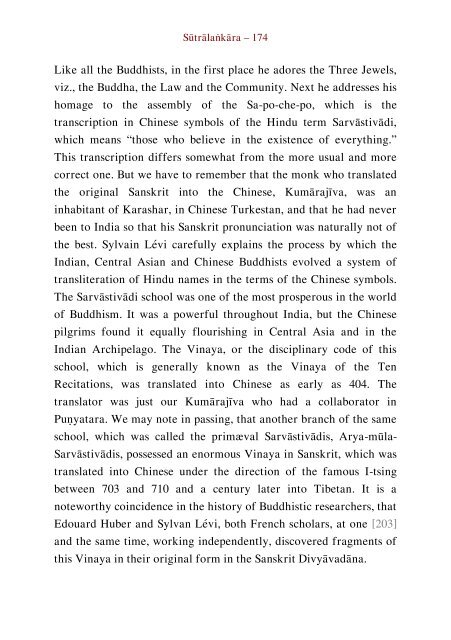Literary History of Sanskrit Buddhism
A study by J. K. Nariman of Sanskrit Buddhism from the Early Buddhist Tradition up to the Mahayana texts proper.
A study by J. K. Nariman of Sanskrit Buddhism from the Early Buddhist Tradition up to the Mahayana texts proper.
You also want an ePaper? Increase the reach of your titles
YUMPU automatically turns print PDFs into web optimized ePapers that Google loves.
Sūtrālaṅkāra – 174<br />
Like all the Buddhists, in the first place he adores the Three Jewels,<br />
viz., the Buddha, the Law and the Community. Next he addresses his<br />
homage to the assembly <strong>of</strong> the Sa-po-che-po, which is the<br />
transcription in Chinese symbols <strong>of</strong> the Hindu term Sarvāstivādi,<br />
which means “those who believe in the existence <strong>of</strong> everything.”<br />
This transcription differs somewhat from the more usual and more<br />
correct one. But we have to remember that the monk who translated<br />
the original <strong>Sanskrit</strong> into the Chinese, Kumārajīva, was an<br />
inhabitant <strong>of</strong> Karashar, in Chinese Turkestan, and that he had never<br />
been to India so that his <strong>Sanskrit</strong> pronunciation was naturally not <strong>of</strong><br />
the best. Sylvain Lévi carefully explains the process by which the<br />
Indian, Central Asian and Chinese Buddhists evolved a system <strong>of</strong><br />
transliteration <strong>of</strong> Hindu names in the terms <strong>of</strong> the Chinese symbols.<br />
The Sarvāstivādi school was one <strong>of</strong> the most prosperous in the world<br />
<strong>of</strong> <strong>Buddhism</strong>. It was a powerful throughout India, but the Chinese<br />
pilgrims found it equally flourishing in Central Asia and in the<br />
Indian Archipelago. The Vinaya, or the disciplinary code <strong>of</strong> this<br />
school, which is generally known as the Vinaya <strong>of</strong> the Ten<br />
Recitations, was translated into Chinese as early as 404. The<br />
translator was just our Kumārajīva who had a collaborator in<br />
Puṇyatara. We may note in passing, that another branch <strong>of</strong> the same<br />
school, which was called the primæval Sarvāstivādis, Arya-mūla-<br />
Sarvāstivādis, possessed an enormous Vinaya in <strong>Sanskrit</strong>, which was<br />
translated into Chinese under the direction <strong>of</strong> the famous I-tsing<br />
between 703 and 710 and a century later into Tibetan. It is a<br />
noteworthy coincidence in the history <strong>of</strong> Buddhistic researchers, that<br />
Edouard Huber and Sylvan Lévi, both French scholars, at one [203]<br />
and the same time, working independently, discovered fragments <strong>of</strong><br />
this Vinaya in their original form in the <strong>Sanskrit</strong> Divyāvadāna.


















